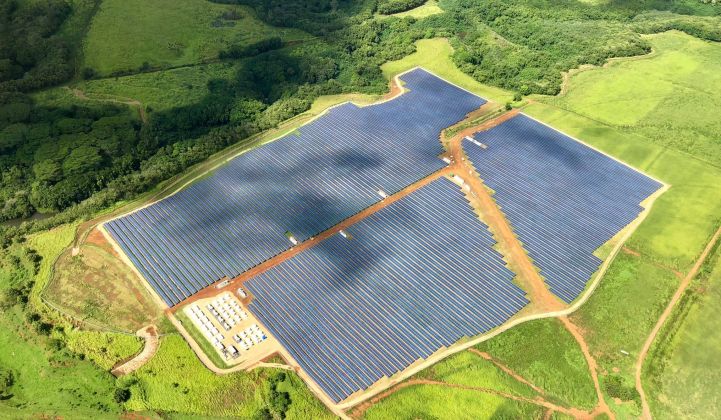Hawaiian Electric issued a long-awaited request for proposals on Thursday for about 900 megawatts of renewable energy and energy storage projects. It’s the utility’s second major round of contracts in the past year seeking to marry variable solar and wind power with the capacity and flexibility of batteries.
But the Variable Renewable Dispatchable Generation and Energy Storage RFPs that opened on Thursday are a bit more complicated than their headline figures might indicate. The RFPs are seeking technologies equal to 594 megawatts of solar for Oahu, 135 megawatts for Maui and up to 203 megawatts for Hawaii Island.
Unlike its first massive solar-storage procurement in January, HECO’s new RFPs are broken into a number of specific projects and specific needs across its three islands, with a mix of different technologies required. This complexity comes from the fact that these RFPs have been structured to help replace two big fossil-fuel-fired power plants to close in the next five years — the AES Hawaii coal-fired power plant that serves about one-sixth of Oahu’s peak demand, set to retire in 2022, and the oil-fired Kahului plant on Maui, set to close in 2024.
This impending loss of two big spinning generators has pushed HECO and regulators to approve a mix-and-match of technology combination to replace them. That will make them hard to compare directly to HECO’s first round of procurements, as well as the utility-scale solar-plus-storage bids on the mainland.
Developers winning HECO's first-round RFP in January shocked the industry with prices ranging from 12 cents per kilowatt-hour to a record-breaking 8 cents per kilowatt-hour, as compared to average Hawaiian solar-storage project prices of 11 cents per kilowatt-hour in 2017 and 13.9 cents per kilowatt-hour in 2016.
Ravi Manghani, head of solar research for Wood Mackenzie Power & Renewables, noted that the winning bids also came with some novel structures, such as PPAs that replaced payments based on energy deliveries to lump sums based on net energy potential and availability, to ensure greater dispatchability for critical hours of the day.
But “the Phase 2 RFP takes a more technically advanced approach toward resource planning,” Manghani stated in a July GTM Squared article in July.
From solar-plus-storage to integrated grid planning
First, there’s a standalone storage component, with HECO seeking about 200 megawatts on Oahu and 40 megawatts on Maui, to provide capacity-like features to the respective island electric grids.
Under the plan submitted to the Hawaii PUC in July, this capacity was fast-tracked for delivery to ensure it’s in place before the power plants close.
Second, it includes a separate call for customer-based grid services such as fast frequency response and capacity for all three islands, in amounts ranging from 4 megawatts on Hawaii to nearly 120 megawatts on Oahu.
“This will create an opportunity for customers to play a direct role in modernizing the electric grid and integrating more renewable energy,” Thursday’s press announcement noted.
Most of these megawatts are in the form of multi-hour capacity that can be served by traditional demand response, but HECO is also seeking a significant share of ancillary services that require split-second responsiveness from the loads or generators involved. HECO’s Integrated Demand Response Portfolio Plan, a long-running proceeding meant to create markets to bring demand-side resources to bear as grid assets, will guide procurements on this track.
Finally, Thursday’s RFP expands on the range of services that the “renewable dispatchable” generation, which will make up the bulk of the procurement, can provide. As set out in the RFP guidelines, this generation will likely consist of solar PV, or perhaps wind or another cost-competitive renewable resource, combined with four-hour-duration batteries, to help shift daytime peak solar production to cover evening peak customer demand.
But beyond that, HECO is also opening up the opportunity for developers to take on a “contingency storage” task providing frequency response, as long as it’s at least 5 megawatts and can operate for half an hour. These are the same characteristics shared by hundreds of megawatts' worth of batteries serving PJM’s frequency regulation market, and they’re meant to serve a similar role for HECO’s island grids.
HECO, which serves some of the most PV-saturated neighborhoods in the country, is already struggling with voltage fluctuations, two-way power flows, and other distribution grid disruptions that call for an increase in these types of frequency regulation services. And these problems will only get worse in decades to come, as Hawaii retires the big spinning fossil-fuel-fired generators that provide inertia and stability to the grid.
But solar farms can be operated in ways that can help balance these grid frequency fluctuations, albeit not without some marginal loss of energy output. First Solar and California grid operator CAISO showed in a series of pilot projects that solar farms can use their inverters to mitigate frequency and voltage disruptions. Dedicating a portion of on-site energy storage to frequency regulation could significantly boost that capability.




